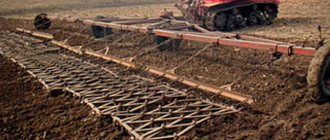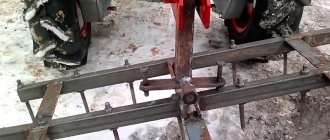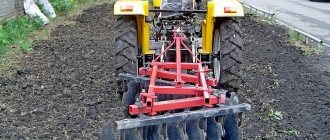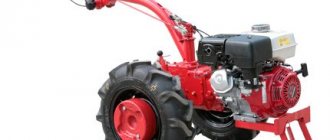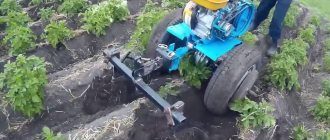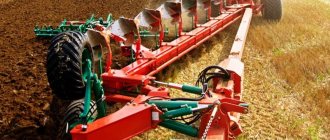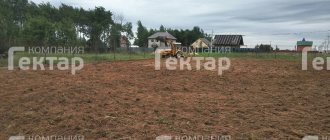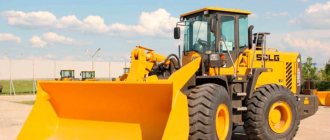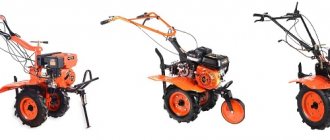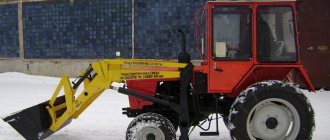Definition
A harrow is an agricultural implement designed for soil cultivation (harrowing). By cultivating the soil with the help of this product, agricultural machine operators prevent the soil from drying out, level its surface, and also remove crust and weeds.
This implement can be used as a separate element and mounted on a tractor using a hitch. Or it can be used in conjunction with other equipment, such as cultivator legs: for example, together with plows or cultivators.
Design
If you want to perform repairs or carry out maintenance, you must carefully study the design of the product. Its basis is made up of rectangular/trough-shaped strips, in which teeth are mounted at the intersection points. They are arranged in such a way that each element can drive a separate furrow during operation.
The distance between such grooves directly depends on the type of device used and can vary from 2.2 to 4.9 cm. In order to avoid the common problem of clogging the working organs with vegetation and clods of earth, it is recommended to mount teeth located in the same row at a distance of more than 15 cm apart.
The depth of the furrow in the cultivated soil directly depends on the weight of the product.
When attached to tractor equipment, a coupling of tooth harrows SG-21/18 or other modifications is used. They can also be coupled with plows, cultivators and other types of equipment.
Types of harrows
Harrows can be classified according to different characteristics. For example, depending on the mass, they can be light, medium, heavy. But from the point of view of practical application in agriculture, division by device is more relevant. Within the framework of this classification, tools are divided into disk, tooth, spring and needle. Let's take a closer look at them.
Disc harrow
The working elements of this type of implement are discs, which is how they got their name. They are located at a certain angle relative to the direction of movement - it is called the angle of attack. By changing it, you can vary the depth of the layer that needs to be processed. Discs for a disc harrow easily crush soil, loosen soil, and cut turf.
Products of this type are suitable for surface tillage of the soil before sowing. With their help, you can mix the top layer of soil, crush the roots of weeds, and restore the natural layer of humus. Disc harrows are designed for pre-sowing soil preparation, stubble peeling, cutting up a layer of perennial grasses, soil preparation after harvesting row crops and grain crops, spring harrowing, and mulching.
In the technology of minimal tillage, harrows increase fertility and restore the natural humus layer. At the same time, the costs of cultivating crops are significantly reduced.
Disc harrows can be divided into two types:
The first is sectional disc harrows of the old design. Their disks are installed on one shaft and assembled into a so-called “battery”. The advantage of such units is their cost. The downside is the difficulty of maintenance and increased winding of plant residues on the shaft.
The second type is disc harrows on an individual stand, the so-called diskators. In such models, each disk has its own stand on which it is mounted. Although such harrows are more expensive than sectional harrows, they are also more convenient to repair. In addition, they cultivate the soil efficiently because they are less clogged with plant debris.
Disc harrows have design differences; in addition, they have a different number of rows of discs, the shape and diameter of the working body, and their purpose is different. In this regard, the following types of technology are distinguished:
- lightweight two-row;
- average;
- heavy on elastomers.
Tooth harrow
In tools of this type, the working parts are designed in the form of teeth. The shape can be different: round, square and others. The front part of the teeth is designed to cut the soil, and the side part destroys lumps. At the same time, soil elements are mixed. Soil cultivation with the help of such products can take place at a depth of up to 10 centimeters. Usually used together with cultivators or seeders.
Types of tooth harrows are distinguished based on the force of pressure per tooth:
| View | Characteristic | Application |
| heavy | 2-3 kg per tooth, depth – 5-8 cm | Suitable for clay and loamy soils. |
| average | 1-2 kg, 4-6 cm | For working with light and loose soils. |
| lungs | 0.5-1 kg, 2-3 cm | Effective for the top layer. |
Spring harrow
Spring harrows are used for cultivating the soil after crops, as well as after harvesting them. The working body is a spring tooth, of different sections for each type of harrow. There are several types of such products: spring mounted harrow, semi-mounted harrow, trailed harrow.
The spring harrow on the cultivator does not harm crops. This tool also helps with fertilizing, collecting and felling straw.
Spring harrows are good for loosening, leveling the top layer of soil, and removing weeds. Such units, equipped with spring teeth and acting on the soil according to the principle of vibration, are suitable for inter-row cultivation, which is carried out carefully, without damaging the plants. They are used for both grain and industrial crops.
Needle harrow
Products of this type are used primarily for erosion control, to destroy ice crusts on winter crops. Also, this type of implement copes well with the early spring closure of soil moisture on stubble backgrounds and smoothing out unevenness remaining after the previous stage of processing.
Rotary hoe
used for loosening, aeration, and incorporation of fertilizers. Externally, it is a beam with rotating teeth. With its help, you can cultivate the land both before sowing and during the growing season. The advantage of this machine is the ability to perform several actions in one pass.
For example, the BRK harrow is designed to solve problems of moisture conservation, removing weeds entirely from the roots and leveling fields. Practice has shown that the tool effectively performs its tasks, especially with such a malicious weed as wheatgrass. In the fields where the pre-sowing treatment with “BRK” was carried out, soil moisture is retained for two weeks longer in the absence of rain, which has a positive effect on the yield and quality of grain.
Comparative analyzes of wheat yields on the part of the field treated before sowing with “BRK” and the part that, as before, was treated with a cultivator, showed an increase of 15%. In addition, fuel and time were significantly saved, which are always in short supply during this period. When processing “BRK” vapors, there is also a pronounced saving in both finances and time, due to the fact that the traction resistance when working with them is 40% lower than the traction resistance of an average cultivator, and the operating speed is up to 20 km/h .
Harrowing the soil
Harrowing is understood as soil cultivation, including technological operations of loosening, mixing and leveling the surface without turning over layers and layers of soil. It is necessary when caring for agricultural plants, to destroy the soil crust and destroy young, immature weeds. Harrowing thins out thickened crops, embeds fertilizers, increases the aeration of the upper arable layer and retains moisture in the soil.
Depending on the cultivated crop, harrowing is carried out after sowing and seed emergence.
The best crumbling and mixing of the soil occurs when it is harrowed at a humidity of 50-70% of its full moisture capacity. When harrowing dry soils, the teeth of the implement go deep shallowly and unevenly, so the blocks are incompletely crumbled and the soil is sprayed. Too wet soil does not mix well, hardly crumbles, and an unfavorable surface microrelief is created.
When harrowing, the tractor is used less efficiently than in other types of soil cultivation; therefore, it is very important to carry it out at higher speeds with fewer harrows in the unit. The combination of harrowing with cultivation and other types of processing is considered the most optimal. This minimizes the adverse impact of heavy machinery on the soil structure. It is recommended to harrow the top layer of a plowed field at a speed of 7-8 km per hour. In the spring, when harrowing winter crops and seedlings of row crops, the tractor speed can be slightly reduced (6 km/h). When harrowing at higher speeds, the necessary loosening of the soil is achieved and labor productivity increases.
Agrotechnical requirements for harrowing
After passing the harrow, the soil should be finely lumpy, with a particle diameter of no more than 3 cm. When harrowing winter crops, row crops and perennial grasses, weeds should be completely destroyed, and no more than 3% of cultivated plants should be damaged. To avoid mistakes, subsequent strips of treated soil overlap the previous ones by 15-20 cm.
Harrowing is used as a method of caring for fallows, crops and grasslands. Harrowing can be carried out separately or simultaneously with plowing, cultivation, sowing and other techniques.
***
Pros and cons of using different types of harrows
Let's talk about the second type of harrow in more detail. The average individual tine disc harrow model may have 2, 3 or 4 rows of discs. Everyone has their own advantages.
By number of rows of harrows
| Double-row harrows | Three-row harrows | Four-row harrows |
| On double-row harrows, when the working tools are arranged at a pitch of 270 mm, with a distance between rows of 800 mm, the implement does not become clogged with a larger amount of crop residues. At the same time, the working width and productivity are greater. | Three-row harrows require less traction force compared to four-row harrows, thanks to which the tractor is coupled with a disc harrow with a larger working width. The three-row model combines the advantages of a two-row and a four-row harrow. It has an increased working width and productivity, while it processes the soil efficiently with fewer passes. | Four-row harrows, compared to three-row harrows, reduce the number of tillage passes by 2-3 times. This happens due to the fact that they simultaneously loosen, crumble the soil, crush plant residues, and level the terrain. Such harrows work better on heavy soils than double-row harrows. |
By weight of disc harrows
| Name | Lightweight disc harrow | Discator | Heavy disc harrow |
| Advantages | · Excellent incorporation of crop residues. · No damage to the capillary system due to the low level of penetration. · Reduced moisture loss due to the absence of excessive soil mixing. · Feasibility of working in wet conditions. | · Excellent incorporation of crop residues from grain to row crops. · Extended range of applications for spring and summer-autumn work. · The ability to perform two operations with one unit, due to the adjustable processing depth. · Reduced moisture loss due to the absence of excessive soil mixing and compaction with a roller. | · Excellent incorporation of crop residues. · Performs basic cultivation on fields with strong soil density, high yields or a huge number of weeds./li> · Creates easy conditions for pre-sowing tillage. |
| Flaws | · Lack of opportunity to disk large-stemmed crop residues. · Unjustified costs when working with large amounts of plant matter and weeds. · The small diameter of the disc will not allow the remains of corn or sunflower to be disced. | · There is no objective possibility of cultivating a field with a huge number of weeds after it has been idle for a long time. · If there is a large amount of large stem residue, you need to make 2 passes, spending more fuel, but at the same time saving time. | · Infeasibility of pre-sowing treatment. · High level of dirt adhesion to working parts when working in wet conditions. · Excessive fuel consumption of the tractor due to the large weight and severe operating conditions. |
The principle of robots and the design of a harrow for walk-behind tractors
The first harrow that man made with his own hands looked like spruce logs tied together. They were not made very long, so that it was possible to maneuver in the fields, but the mass of the harrow was too large, which made it possible to break up blocks of earth after plowing and retain natural moisture in the ground.
Today, this unit is used both independently and with other types of devices such as seeders and cultivators. The harrow copes not only with blocks of earth, but also covers the soil, leaving moisture inside it. The technical characteristics of the harrow also allow it to collect dry plant residues and pull out weed roots.
This is a device that has passed centuries and has managed to be modernized so much that when using it, a minimum of human effort is required. There are several types of harrows:
- disk
- rotary
- dental
The technical characteristics of the harrow comply with generally accepted standards and are calculated based on the mass per disc or tooth. Accordingly, based on this classification, there are heavy, medium and light harrows. And their use can be special or general.
What to look for when choosing a harrow
Purchasing any trailed and mounted mechanisms allows you to get a relatively inexpensive device for work that can efficiently perform the functions assigned to it.
When choosing a tool for production, you need to rely on what types of harrows are available and what problems they will help solve. Before deciding on a model, it is important to evaluate your needs and understand what exactly the unit will be used for: surface treatment, weed control or deep disking. In addition, when choosing a harrow, regardless of the type, it is usually recommended to pay attention to the following characteristics:
- Working width. The larger the area to be treated, the larger it should be.
- Dimensions of the working body. It is worth considering the desired processing depth.
- Performance and weight. They are determined according to the unit with which the harrow will work.
- Price.
In addition, it is worth paying attention to the trail roller, which is located on the harrow. Based on the method of attachment to the harrow frame, train rollers are divided into “free” rollers and support rollers.
| Free train roller | Support train rollers |
| A “free” roller is cheaper, but its functions are limited: it levels the soil and crushes soil clods. | Supporting ones ensure control of the depth of tillage and its uniformity along the entire length of the implement, as well as crush clods of soil and level the soil |
The next important point when choosing is the frame. It can be folded or not folded.
| Folding frame | Non-folding frame |
| Allows you to travel on public roads in accordance with traffic regulations | Less expensive and suitable for those who do not plan to move such harrows on public roads |
It is important to pay attention to the attachment of the working element to the frame. The harrow can be equipped with a conventional or lubricated tine.
| Regular stand | Lubricated stand |
| An ordinary stand, after prolonged use in aggressive environments, may no longer rotate in the frame mount. If you need to remove it, you will have to spend quite a lot of time on this process. However, some set one harrow attack angle and do not change it in the future. This means you don’t need to pay for an extra option. | The lubricated rack is equipped with a screw groove into which grease is pressed through a grease nipple. In the future, when working in an aggressive environment (sand, dust, precipitation, temperature), the stand does not “stick” to the frame and you can freely change the angle of attack of the working element. During repairs, the rack can be freely removed from the frame. |
We must not forget about the angle of attack of the working disks, where the best performance indicators are achieved at 16 degrees of the front row of disks and 14 degrees of the rear row of disks.
The cutting angle of the discs is also very important, because the throughput of the unit and penetration into the soil depend on it, regardless of its hardness and the amount of plant residues. Twenty degrees is the standard cutting angle, and all other indicators are half measures. It is better to choose a machine with fixed angles of attack: units with angle adjustments and a complex design are more prone to breakdowns. And now most manufacturers produce designs with an optimal angle of attack.
Applications for the tine harrow
The first type of product is used in cases where the farmer seeks to obtain loose, even soil. The teeth are spaced evenly throughout the structure and can have different shapes and sizes. Most equipment owners perform harrowing with a walk-behind tractor equipped with equipment equipped with square teeth, although sometimes equipment with round or knife teeth is also used.
You can attach such a harrow to a walk-behind tractor by connecting it to the frame. For this, hinges or a spring strut are used. Farmers often use a walk-behind harrow, which is attached by means of an oscillating or rotating frame. Rotary harrows are used quite actively on the farm. They are quite reliable and perform a wide range of functions.
How to choose a harrow for the type of task
We have already said that when choosing a harrow you need to understand exactly what functions you plan to use. However, without experience working with different types and types of harrows, it is difficult to know what to expect when working with different units.
For peeling stubble after grain crops
there is no need to take a heavy disc implement - a light harrow will do the job, but for discing large-stemmed predecessors such as corn and sunflower, a heavier machine will be required. It is important to take into account that if it starts to rain after harvesting corn (which often happens), a heavy disc harrow will not cope: in wet conditions it will quickly clog. Therefore, it is better to choose a lighter unit and make an additional pass across the field, saving time but increasing fuel consumption.
For better alignment
(for example, when plowing) you can use additional equipment (leveling discs).
For mechanical destruction of existing weeds and preventing their further emergence
Modern double-row disc harrows are used (necessarily with a roller or roller system).
Not everyone understands what the diameter of the disc affects
in disc harrows. For farms whose fields have a lot of plant residues (for example, after corn), it would be a huge mistake to save on purchasing a disc implement with a small disc diameter. Conversely, there is no point in taking a unit with a large disc if we are going to cultivate the soil after grain crops. Tools with a medium disc diameter are universal. They are suitable in most cases where the main crops in crop rotation are grains, vegetables, root crops or low-stemmed industrial crops with average or above average yields.
To work with smooth discs (without cutouts), you need a dense surface, and if the soil is light or wet, then the density is not enough - the discs will “hang”; the same disc, but with small cutouts, will be guaranteed to cling to the soil and rotate perfectly.
For example, if there is a lot of rain while planting grain stubble and the base of the field is soft, then smooth discs are not the best option, nor are discs with small cuts. Or if, after harvesting sunflower and corn, you have to disk the stubble after rains, then it is better to take disks with large “chamomile”. And if you have to work through wheat stubble in dry conditions, the best choice is discs with small cuts.
Criterias of choice
Before you start purchasing a harrow for a walk-behind tractor, you should decide on the type of soil on which the equipment will be used, as well as the type of processing. So, to develop soft virgin lands, it is better to purchase a rotary model. Despite the small depth of penetration into the soil, it is with the help of this equipment that it is possible to prepare the soil for planting crops as much as possible. In addition, a rotary harrow will be an ideal option when preparing a field for winter after harvesting potatoes.
If there is a large amount of weeds on the site, which need to be dealt with quickly and effectively, then the best option would be to purchase a disk model.
The discs cope well even with fairly thick roots and leave them no chance.
If you need to harrow the soil deeply, while simultaneously protecting it from excessive drying, then it is better to choose a needle model. Such products are able to penetrate deeply into the soil and leave behind a fairly smooth surface.
If the site is cultivated every year and contains soft and well-groomed soil, then there is no point in overpaying for more functional equipment, so purchasing a classic dental model will be quite enough.
See below for more details.
Comparative characteristics of harrows
| Harrow name | BZPT21 | BMR-12 | BMR-18 | BPGP-15 | BPGP-17 | BPGP-21 | BPGP-23 | BMR-5.6 | BMR-6.2 | BMR-8.7 | BRK-8 | BRK-3.8 | BRK-7.6 | BRK-11.4 | BZSS-1.0 | PM 3x4P | PM 4x4 P | PM 6x4 P | PM 6.5x4 P | PM 8x4 P | Paper machine 2.5x2 n | PM 3x5 P | PM 4x5 P | PM 5x2P | PM 6x2 P |
| Type | trailed | trailed | trailed | trailed | mounted | trailed | trailed | semi-trailer (semi-mounted) | mounted | trailed | |||||||||||||||
| Working width, m | 21,4 | 12 | 18.2 | 15 | 18 | 21 | 24 | 5,6 | 6,2 | 8,7 | 8 | 3,8 | 7,6 | 11,4 | 0,95 | 3 | 4 | 6,5 | 6,5 | 8,2 | 2,5 | 3,5 | 4,5 | 5,5 | 6,5 |
| Productivity, ha/h | 25-38 | 12-18.3 | 17-27 | 15-22 | 18-27 | 31-32 | 25-36 | 5,6-8,4 | 6,2-9,3 | 8,7-13,5 | Up to 14.5 | Up to 6.8 | Up to 13.6 | Up to 20.4 | Up to 1.2 | 3-4 | 4-5 | 6-7 | 6-7 | 6,8-8,4 | 2,1-2,3 | 3,75 | 5 | 5,57 | 6,25 |
| Operating speed km, h | 12-18 | 10-15 | 12-18 | 10-15 | Up to 20 | 10-12 | 8-12 | 8-15 | |||||||||||||||||
| Working body diameter, mm | 520 | 14-16 | 520 | up to 80 | |||||||||||||||||||||
| Processing depth, mm | 40-120 | 50-60 | 40-120 | 50-60 | 60-80 | ||||||||||||||||||||
| Number of working bodies, pcs | 175 | 1 | 145 | 165 | 185 | 205 | 52 | 56 | 80 | 32 | 40 | 60 | 60 | 80 | 18 | 24 | 30 | 38 | 46 | ||||||
| Dimensions (LxWxH), mm | 22080x8875x1550 | 7150x12430x1080 | 10200x18000x1080 | 9000x15700x15600 | 1705x4360x1145 | 7330x2330x1550 | 6960x3600x1550 | 6800x8500x2300 | 7000x4200x1500 | 10000x8400x1500 | 10000x12600x1500 | 36100 x 6700 x 15600 | 44100x 67 00x15600 | 65700x 6900x 15600 | 65700x 6900 x 15600 | 43900 x 73600 x 3900 | 2500x1800x1600 | 34700 x 62000 x 15600 | 44700 x 62000 x 15600 | 55700x 62000 x 15600 | 65700 x 62000 x 15600 | ||||
| Weight, kg | 6800 | 2350 | 3700 | 5200 | 6000 | 6500 | 7000 | 700 | 990 | 1430 | 5000 | 2300 | 5300 | 8000 | 40,00 | 3510 | 3650 | 5250 | 5250 | 7550 | 750 | 2550 | 3250 | 3750 | 3950 |
| Required tractor power, l/s | 184-265 | from 120 | from 150 | from 160 | from 200 | from 300 | from 350 | 80 | 120,00 | 150-180 | 200-240 | 300-350 | 300-350 | 400-450 | 80-100 | 120 | 150 | 180 | 210 | ||||||
Design features of a homemade harrow
The optimal and simplest option for making it yourself is a tooth harrow. To create it, you will need to carefully study the drawings, which should indicate the sequence of actions when assembling the equipment
It is also very important that the diagrams indicate the dimensions of all parts used for the manufacture of the harrow
The design itself, in appearance, resembles a frame cage to which the teeth are attached using bolts. The front part of the structure must be equipped with a towing device, which, in most cases, takes the form of a hitch with holes. When installing on a walk-behind tractor, the hitch will need to be inserted into the tow bar pipe, and then secure both elements with a finger
It is extremely important to weld a special chain between the tow bar and the hitch, which will make working with the equipment easier
The cage of the tooth harrow should be as strong as possible, so for its manufacture you should use square or water pipes, as well as corners to strengthen the joints of the structure. Each part must be made of steel with a thickness of at least 5 mm, otherwise the soil will tear out the teeth along with pieces of metal.
The design of the manufactured grating must consist of transverse and longitudinal parts. At the same time, the best option would be a cage in which the rods are welded together at an angle of 45⁰ relative to the direction of movement of the walk-behind tractor. Such a homemade harrow will be subject to much less bending loads.
To determine the size of the cells, you will need to first determine how the teeth will be placed on the harrow. To do this, you need to draw the teeth on the drawing, and on top of them draw a grid on which they should be attached. The frame itself must be of such dimensions that it does not subsequently interfere with working with the walk-behind tractor
It is also extremely important to take into account the dimensions of the coupling device in a timely manner. It must be remembered that many walk-behind tractors simply cannot pull a harrow more than 1 m wide.
It is best to use corrugated reinforcing steel to make teeth. Its diameter should be at least 18 mm, and the length of each tooth made should be about 15 cm. The height of the tooth does not depend on the height of the coupling device, since the homemade harrow will be attached to the walk-behind tractor using a chain. In this case, the thickness of the latter should be increased if thick teeth are attached to the harrow.
Unnecessary combinations
One of the mistakes when choosing a disc implement is the preference for unnecessary combinations, for example, a combination of discs and cultivator tines in one machine, for example, a disc-tine implement.
A properly selected disc harrow mixes a large amount of plant residues and cuts weeds to a specified maximum depth for the selected model at a speed of 12 to 16 km/h.
A good three-beam tine cultivator also copes with intense mixing, but operates at a maximum speed of 11-12 km/h, since the wear of the working parts increases with increasing speed.
It would seem that when combining discs and cultivator tines, the farm has only advantages: together, the combined implement can crush and mix plant residues, and carry out deep loosening to a sufficient depth.
However, this approach has a significant drawback, which is the difference in the operating speeds of the cultivator discs and tines. As a result, by performing two operations in one pass, the farmer does not receive high-quality soil tillage, has excessive fuel consumption, and in addition, the wear of the working parts of that part of the unit, which in principle should move slowly, increases.
But most importantly, the cost of purchasing a combined unit is 70% higher than a separate machine. In his opinion, it is necessary to compare the pros and cons before purchasing such machines and not pay more where there is no need for it.
If you purchased a unit of this type, then be prepared to constantly replace rubber dampers. In addition, on disc harrows with rubber dampers, as their elasticity loses or soil density changes, it is necessary to center the location of the front row of discs relative to the rear row by eye. If this is not done, then there can be no talk of any quality of tillage. However, such adjustments are not always carried out when working in the field, the specialist regrets.
By investing a slightly larger one-time amount, you get a truly professional tool for work.
Weights for walk-behind tractors
The main problem for the Neva MB walk-behind tractor is slipping on wet ground and on inclines. With a low weight (98 kg), the unit does not exert sufficient pressure on the ground to create reliable traction. Lightweight attachments do not help eliminate this disadvantage.
To increase the weight, the following devices are attached to the motor-cultivator and walk-behind tractor:
- Wheel weights. Factory products are monolithic iron circles or hollow containers filled with sand. Homemade products are not inferior to their factory counterparts in quality. They are made from barbell discs, cast from concrete, or assembled from parts of a metal barrel. The weights are attached to the axle hub. Their weight can be 20-50 kg per wheel.
- Body weights. They are made in the form of a frame from steel corners, rigidly fixed to the frame of the unit. Drawings and calculations are made in advance so that the frame fits exactly into place. Pieces of iron or containers with water/sand are attached to the frame.
- Steel wheels with lugs. These products have a steel strip instead of a tire, to which plates of the same material are welded. The diameter of the lugs varies between 30-70 cm, width - 10-20 cm, weight - 15-50 kg.
By making the walk-behind tractor heavier, you can count on its smooth progress across the site even when cultivating virgin soil. After this, you need to purchase or make your own attachments for the Neva walk-behind tractor. The scope of agricultural activity is quite wide; to cover it all, you will need a wide variety of attachments for the Neva MB 2 walk-behind tractor.
Configuration errors
A correctly selected disc harrow does not need any settings (except for setting the working depth and leveling the horizon using the tractor hitch or the hydraulic drawbar of the implement itself).
1. One of the characteristic errors in the operation of disc harrows, especially double-row ones, is the uneven penetration of the working parts of the machine. Namely, the excessive deepening of the front row of the disk battery.
2. However, if you configure the disc harrow in this way (the front row is lower), then, taking into account that the front discs are already working in denser soil, it turns out that the machine will “lead” at an angle to the line of travel either to the right or to the left in depending on which direction the front row of discs is directed.
In addition, both the frame itself and the bearings on the front row of the disk battery suffer, which fail faster. And the rapid and frequent failure of the bearings in the first row of the battery indicates that it was too deep and unevenly buried relative to the rear row and took on the entire load.
Here, rather, the opposite is recommended: to slightly grind the front row of discs in order to equalize the soil resistance to cultivation for the front and rear row of discs, which goes along the already “opened” layer. But what the difference in the stroke depth of disk batteries should be cannot be rigidly determined by a “tabular method”; this is precisely the case for fine adjustment in the field.
DIY tooth harrow
A homemade tooth harrow for a walk-behind tractor differs from a factory one in the quality of the material from which it is made. The factory model is made of structural steel that can withstand large and intense loads. Let's look at how to make your own harrow with the same properties.
A do-it-yourself tooth harrow for a walk-behind tractor can be made by any craftsman. This process is not difficult. The design is simple and does not have complex connections.
First, you need to design a harrow on a walk-behind tractor with your own hands with drawings that give an idea of the dimensions, connections and general layout.
The tool is made of steel strip, square pipe or angle.
The algorithm for manufacturing a dental device is as follows:
- Metal strips at an angle of 30° to each other are welded to the pipe from the bottom side. The edges should protrude evenly on both sides.
- A sleeve is installed in the middle by welding. Using a finger, the harrow is connected to the walk-behind tractor through the bushing. The lifting height should be adjusted by the stand for the depth of loosening.
- Teeth are installed on each edge of the steel strip using bolts or welding.
- A drawbar is mounted on the bushing.
- A screw is attached to the drawbar to adjust the position of the teeth. The front and rear tines should sink equally into the soil.
Experts recommend making the working elements of the harrow from hardened steel. It is better to make the teeth from corrugated reinforcing steel with a diameter of 10-14 mm and a length of 10-20 cm. The longer the teeth, the thicker they should be. They must be sharpened and hardened before attaching them to the frame, otherwise they will bend.
A do-it-yourself tooth harrow for a walk-behind tractor is an excellent helper for small farmers and summer residents cultivating their plots.
Operation errors
1. A disc harrow is a tool with which you can do anything in the field except turn on the spot in a buried position. Alas, such a mistake in the pursuit of output occurs in 30-40% of machine operators. The result is wear of the implements and bearings, failure of the roller, and increased load on the frame. And this is only part of the consequences of such a maneuver.
2. In addition, the speed limit must not be exceeded, as the load on the frame structure and all components increases sharply. But it makes no sense to drive at speeds below 12 km/h.
The advantage of disc harrows, including short ones, is their speed. Only at high speeds do discs of small and medium diameter rotate in such a way that they create the desired agronomic soil structure - 70% of lumps from 1 to 3 mm in diameter. If the disks begin to rotate at a lower speed, the quality of processing will be worse - the number of small lumps will decrease.
3. As for the operation of the tractor, as a rule, it is slowed down and prevented from developing the required speed by an incorrectly selected working width of the implement. Here, you either need to choose a smaller disc harrow, or a more powerful tractor; it is better to select a machine with power reserves. The power of the tractor must also be compared with the depth of tillage.
Usefulness of Attachments
The walk-behind tractor itself is a unit consisting of a frame, engine, wheels and steering wheel. Additional equipment can be attached to it, in this case a harrow. This tool is installed without interfering with the design of the motor unit, which greatly facilitates the modernization process. A harrow is one of the tools that allows you to improve the quality of the soil in the process of cultivating a plot of land. With its help, it is easy to cultivate large areas for planting both grain and vegetable crops.
Common misconceptions when choosing harrows
1. There is no need to buy heavy disc harrows if you have the opportunity to purchase a disc harrow and dig deeper with your paws - if you look at the efficiency of soil cultivation with paws and discs, you can see that they have a fairly large difference in working speeds. For effective processing, discs need a speed of at least 12 km/h, while the processing speed with paws is up to 11 km/h. As a result, peak efficiency is not achieved “in either direction” due to significant wear and tear on that part of the unit that must move slowly.
2. It is impossible to achieve high speeds when working with a diskator, a maximum of 14 km/h - the working width of the implement and engine power have a key influence on the operating speed of the diskator. So a new tractor with a rated power of 300 hp. reaches about 18 km/h with a 6-meter grain disker after the combine. If you correctly adjust the depth of the disks, the speed of work will increase - this is partly true, because the optimal amount of soil will resist the diskator. But the correct depth is an agronomic factor, and therefore the speed of work is characterized by the proportion of working width / tractor power, and the correct setting has a 5-10% (up or down) influence on the speed of work.
3. Bearing units of disk drives quickly fail - maintenance-free bearing units, on average, are able to close the season without replacement, if the unit is used correctly. A common mistake in setting up is recessing the front row of discs deeper than the rear row. This error is argued by the fact that the front discs encounter a denser layer of soil than the rear one. But in this situation, it is overlooked that the car begins to “lead” to the sides depending on the direction of the front row of disks, the lateral load on the bearings increases and there those bearings that are designed to withstand their load receive additional (that which the bearings should have received back row).
Homemade tooth harrow for walk-behind tractor
It is easiest to make with your own hands. To do this, it will be enough to have materials, a grinder and a welding inverter. Allows for pre-planting loosening of the soil and placement of small seed. It is not a power harrow and is suitable for working with a traction-type walk-behind tractor.
Design
Drawing of a harrow for a walk-behind tractor
A harrow is a grid to which teeth are rigidly welded or bolted. In the front part it has a towing device - usually it is a hitch with holes, which is inserted into the towbar pipe of the walk-behind tractor and then fixed with a finger. It is necessary to weld a chain between it and the hitch - without this, the work will be very difficult for the plowman.
The grate must be strong enough. It can be made from square or water pipes and angles. The thickness of the metal must be at least 3-4 mm, otherwise the teeth welded to the thin-walled pipe will break out during operation along with the pipe metal.
The lattice design can be in the form of a cage consisting of longitudinal and transverse elements. But a grid in which the “rods” are welded at an angle of 45 degrees to the direction of movement of the walk-behind tractor is better suited - such a grid will be less subject to bending loads.
The cell size is selected according to the location of the teeth. It’s best to figure out in advance how your teeth will be positioned, sketch it out in the drawing, and then draw a grid on top of them to which they are attached. The size of the frame itself should be such that it does not interfere with driving and following the walk-behind tractor.
The harrow frame should not extend beyond the handles of the walk-behind tractor.
In this case, it is necessary to take into account the dimensions of the coupling. There is no need to make a grill that is too wide - the walk-behind tractor simply cannot handle more than 1 meter.
The teeth are best made from corrugated reinforcing steel with a diameter of 10 to 18 mm. The length of each tooth is from 10 to 20 cm. The height of the walk-behind tractor coupling does not affect the height of the tooth - the harrow is attached using a chain. The longer the tooth, the thicker it should be. It is advisable to sharpen the teeth before installation and be sure to harden them, because unhardened teeth will bend during operation. On light soils, you can use a harrow with unsharpened teeth.
The frequency of their location should be no less than every 10 cm - if done less frequently, harrowing will be ineffective. It is allowed to place the teeth with a slight offset across the row so that they can be conveniently welded and provide the required processing intensity. At the same time, it is necessary to calculate that their resistance is directed symmetrically to the traction axis, otherwise the walk-behind tractor will “wobble” and it will be impossible to harrow with it.
Assembly
Assembly is carried out after preliminary drawing and procurement of all parts. First, the grate is assembled and welded. After this, the teeth are welded to it. It is important to do this at a right angle. As a rule, hardened teeth do not anneal after welding and their strength does not change.
After this, it is determined where approximately the center of application of forces will be located and the chain is welded to this place. Take the first link of the chain and overlap it onto the grate. After this, the second end of the chain is welded or bolted to the hitch. The performance of the harrow is checked after fastening, and if necessary, the chain is welded to the left or right, if the harrow leads in one direction or another, then it is finally welded.
Summarizing
It’s not difficult to make a harrow for a walk-behind tractor with your own hands; you can find good drawings. For each type: disc, tine and rotary harrow, there will be a different scheme. Choose devices depending on your capabilities and the purpose of its use.
Having studied the diagrams and selected the necessary materials, you can easily assemble a good device for cultivating the soil.
Sources
- https://vyborok.com/rejting-luchshih-boron-dlya-motoblokov/
- https://kalibrtractor.ru/spetstehnika/borona-dlya-motobloka-svoimi-rukami.html
- https://arendavlg.com/motobloki/kak-sdelat-boronu-dlya-motobloka-svoimi-rukami-po-chertezhu.html
- https://MoyMotoblok.ru/navesnoe-oborudovanie/samodelnaya-borona-na-motoblok-svoimi-rukami/
- https://PrideSaratov.ru/selhoztehnika/samodelnaya-borona.html
- https://oselhoztehnike.ru/mini/borona-dlya-motobloka.html
- https://www.vseinstrumenti.ru/rashodnie_materialy/sadovaya_tehnika/dlya_kultivatorov_i_motoblokov/vspashcka_zemli/okuchniki/
- https://vospari23.ru/kak-boronit-ogorod-motoblokom/
- https://lizing-spectehniki.ru/motobloki/borona-dlya-motobloka-svoimi-rukami.html
- https://SpecMahina.ru/motoblok/borona-dlya-motobloka.html
- https://motoblok-kultivator.com/borona-dlja-motobloka-svoimi-rukami/
- https://waysi.ru/uchastok/landscape/kak-vybrat-boronu-dla-motobloka.html
[collapse]
